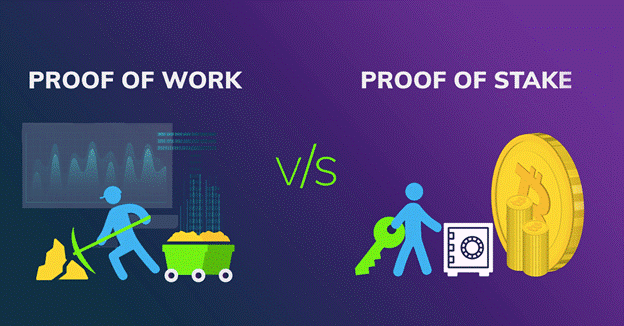Proof of Work vs. Proof of Stake: A Basic Mining Guide
Proof of Work and Proof of Stake: You may have recently heard of the idea of moving away from the Ethereum consensus-based Proof of Work (POW) system to the so-called Proof of Work participation (English Proof of Stake). This article explains the critical differences between Proof of Work and Proof of Stake and clarifies the definition of mining, the process by which new digital currencies are released over a network. And what will change in terms of mining technology if the Ethereum community decides to move from “work” to “staking”?
This article acts as an essential guide to understanding the above issues. If you’re looking for a more detailed guide, take a look at the Ethereum Blockchain Course
What is Proof of Work?
The proof of work is a protocol whose primary purpose is to thwart cyberattacks such as distributed denial of service (DDoS) attacks that aim to run out of computer system resources by sending multiple fake requests. The concept of proof of work existed before Bitcoin, but Satoshi Nakamoto applied this technique to him. I still don’t know who Nakamoto is. Digital currencies have revolutionized the traditional way of establishing transactions. But so far, Proof of Work is the most significant idea behind Nakamoto’s Bitcoin white paper published in 2008. This is to enable distributed, non-trust-based consensus.
What is a non-trust-based distributed consensus?
A decentralized and unreliable consensus system means that you don’t have to trust third-party services if you want to send or receive money from someone. If you use traditional payment methods, you need to trust a third party (Visa, MasterCard, PayPal, bank, etc.) to make a transaction. They maintain their private ledger that stores transaction history and balances for each account.
Here is a typical example that better illustrates this behavior: If Alice sends $100 to Charlie, a trusted third-party service will debit from Alice’s account and credit Charlie’s account, so both parties need to trust that this third party does the right thing there. With Bitcoin and other digital currencies, everyone has a copy of their ledger (blockchain), so everyone can see the written information directly, without having to trust a third party.
Proof of Work and Mining
If we go deeper then we will realize the proof-of-work is a requirement that defines the expensive computational computations and also it must be performed to generate a new set of trustless transactions on a distributed ledger which called a distributed ledger of the transaction piece.
What is Proof of Stake?
Proof-of-stake is another way to verify transaction-based and achieve distributed consensus. It is still an algorithm with the same purpose as Proof of Work, but the implementation process is very different. The first proof of stake idea was proposed on the Bitcoin talk forum in 2011, but the first digital currencies to use this method was Peercoin in 2012, along with ShadowCash, Nxt, BlackCoin, NuShares/NuBits, Qora, and Nav Coin. Unlike proof-of-work, where algorithms reward miners for solving mathematical problems to validate transactions and create new blocks, with proof-of-stake, the creators of new blocks are wealth chosen based on their deterministic way, also defined as participation.
No block reward
Furthermore, all digital currencies are pre-created at the outset, and their amount never changes. This means that in a PoS system, there are no block rewards so that miners can collect transaction fees. This is why, in fact, in this PoS system.
Why does Ethereum use PoS?
The Ethereum community and its creator, Vitalik Buterin, are planning a hard fork to transition from proof-of-work to proof-of-stake.
But why do they switch from one to the other?
In a decentralized consensus-based on proof of work, miners need a lot of energy. A single Bitcoin transaction requires the same electricity to power 1.57 US homes a day (2015 data). And because these energy costs are paid in fiat currencies, there is constant downward pressure on the value of digital currencies. In a recent study, experts believe that Bitcoin trading could consume as much electricity as Denmark by 2020. Developers are very concerned about this issue, and the Ethereum community wants to use the proof-of-stake approach to achieve a greener and cheaper form of consensus. Also, the rewards for creating new blocks are different: with proof-of-work, miners may not own any digital currency they are mining. In Proof of Stake, the counterfeiter is always the one who holds the mint.
Proof of Work vs. Proof of Stake: Conclusion
Thanks to the PoS system, validators don’t have to use their computing power, as the only factors that affect their chances are their own total amount of coins and the current network complexity. So this possible shift from POW to PoS in the future could bring the benefit which is mentioned below;
Energy-saving
As attacks become more expensive, the network becomes more secure: if a hacker wants to buy 51% of the total amount of coins, the market moves with a rapidly rising price. In this way, CASPER will become an escrow protocol that relies on an economic consensus system. As new blocks are created, nodes (or validators) must pay a deposit to become part of the consensus. Due to the control over the collateral deposit, the Casper protocol will determine the specific reward amount that validators receive. For further details visit our recommended site.

